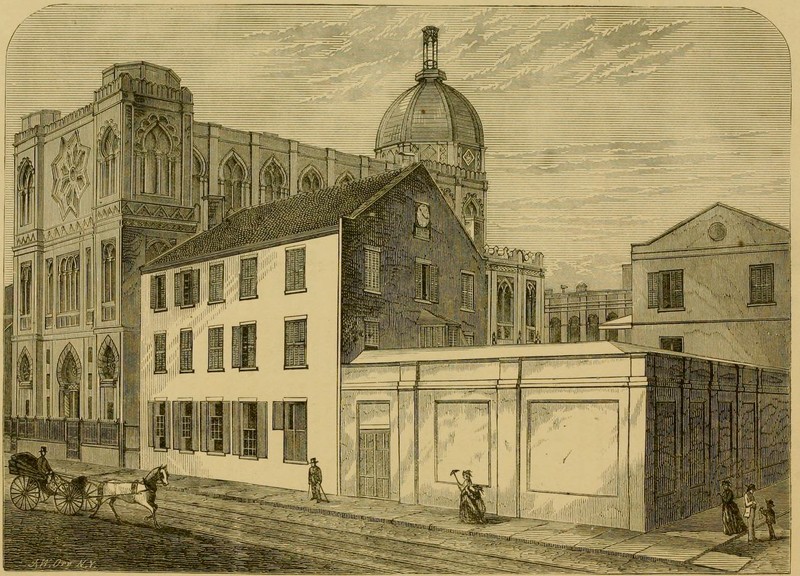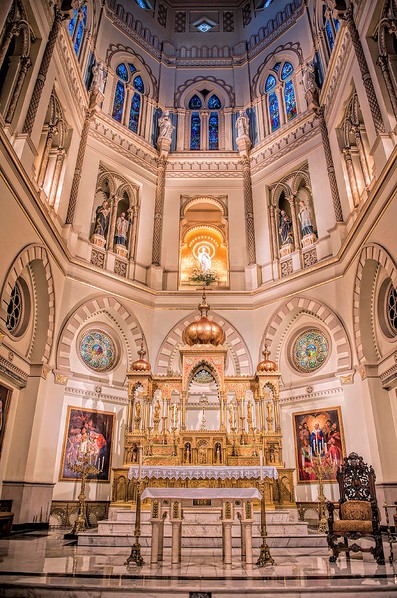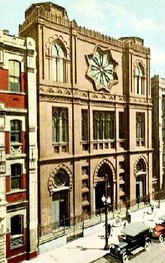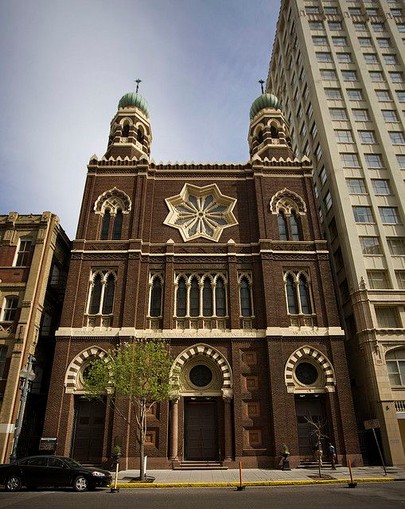Immaculate Conception Jesuit Church
Introduction
Text-to-speech Audio
Constructed four years before the Civil War, Immaculate Conception Jesuit Church is one of the most elegant of New Orleans' historic churches and is just steps from the intersection of Baronne and Canal Streets. The church's original building was completed in 1857 and later suffered severe structural damage the early 20th century. Immaculate Conception was then rebuilt and dedicated in 1930. The interior is replete with art and decoration in Moorish Revival style, as is the building's grand façade.
Images
Church of the Immaculate Conception, illustrated in "Jewell's Crescent City Illustrated,"1873.

View of the main altar, crafted in Lyons, France, in 1867. Image courtesy of Fine Art America.

Façade of the church, circa 1880.

Its original building was constructed during the Antebellum period. Today, Immaculate Conception connects modern society with numerous aspects of New Orleans' past.

Backstory and Context
Text-to-speech Audio
Immaculate Conception Church, also known as the Jesuit Church, was originally designed by Father John Cambiaso in the 1850s. The building serves as a reminder of New Orleans' French and Catholic history, which dates back to the earliest days of European settlement. Father Cambiaso, a native of Lyons, France, utilized a plot of land that was part of the Jesuit Order's original parcel deeded in the 18th century. Having spent time in Spain, Father Cambiasco was enamored with the Moorish architecture. The Moorish design prevalent in Spain provided inspiration for his designs.
The site of the new church bore soft soil and swampy portions, so in addition to draining the property, Father Cambiaso tried to modified his plans to accommodate the less-than-ideal terrain for such a monumental building. Unfortunately, his efforts were inadequate, a point revealed in the 1920s. When the church was originally constructed, it was flanked by an auxiliary and much simpler building to serve as a residence and school (this is the structure to the right of the church in the 1873 illustration below). This secondary annex was sold in 1920 and demolished to make way for what would become known as the Père Marquette Building. The disruption of this construction caused significant damage to the church's foundation such that the entire structure had to be rebuilt.
Painstakingly disassembled and then reassembled beginning in 1929, Immaculate Conception Church was re-dedicated on March 2, 1930. Among the numerous splendid interior features, one can highlight the magnificent altarpiece, designed by New Orleans native Jame Ferret and hand-crafted in Lyons, France, in 1867. It also originally housed the 1884 Louisiana Cotton Exposition Organ, although this has since been replaced by a more modern instrument.
The 1884 Cotton Exposition is no sidenote in history, however. Alongside French Catholicism, New Orleans enjoyed a large creole population and influence, where Native Americans, Africans, Caribbeans (mostly of African heritage), and Europeans congregated in a city that stood as an epicenter of cotton exchange. Hundreds of years of Atlantic Word activity that included the forced transportation of several million Africans coincided with the development of the sugar trade, cotton trade, and other labor-intensive farming industries in the Western Hemisphere. In addition to the humor horror stories, political stresses, and economic history, a rich cultural history emerged. The church's original organ that was used in the 1884 Cotton Exposition serves as a reminder of New Orleans history that's tied to slavery, cotton, and one large facet of the human element tied to the Columbian Exchange.
Sources
"The Church." Immaculate Conception Jesuit Church. Retrieved 9 January 2017. http://jesuitchurch.net/learn/the-church; Shannon Lee Dawdy, Building the Devil's Empire: French Colonial New Orleans (Chicago: University of Chicago Press, 2008), discusses the development of New Orleans during the 18th Century, notably its French influence. She also reminds readers in her Preface that much of the French Quarter was rebuilt after a fire during a period when it was ruled by the Spanish.
The sources detailing the immensely complex and diverse New Orleans history are innumerable. A few selections for background include John Thornton, Africa and Africans in the Making of the Atlantic World, 1400-1800, 2nd Edition (New York: Cambridge University Press, 1998), esp. 206 - 235; Adam Rothman, Slave Country: American Expansion and the Origins of the Deep South (Cambridge: Harvard University Press, 2005) 73-82, 162-229; Christopher Morris, "Impenetrable but easy: The French Transformation of the Lower Mississippi Valley and the Founding of New Orleans," in Transforming New Orleans and Its Environs: Centuries of Change, ed. Craig E Colten (Pittsburgh: University of Pittsburgh Press, 2000), 22-44; Alfred W. Crosby, The Columbian Exchange: Biological and Cultural Consequences of 1492, 30th Anniversary Edition, (Westport, CT: Praeger Publishers, 2003).
